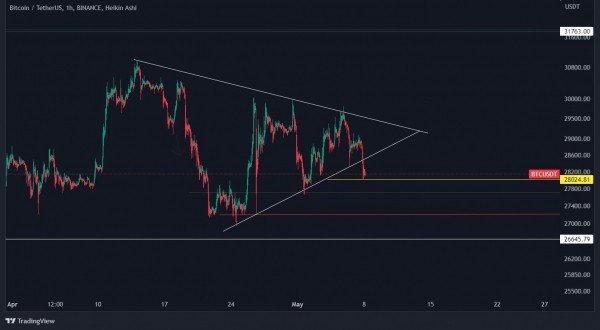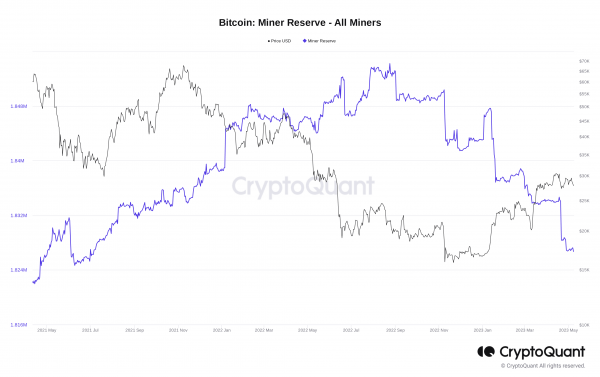Binance ‘FUD’ meets CPI — 5 things to know in Bitcoin this week
A spike in transaction fees and repeated BTC withdrawal outages at Binance provide a fraught backdrop to a week of Bitcoin volatility triggers.

Содержание статьи:








Bitcoin (BTC) starts a new week at the center of new crypto industry drama as the highest fees in two years pressure price action.
Downside volatility is greeting traders thanks to a full mempool, and explanations point the finger at multiple parties.
The largest exchange, Binance, is adding to the confusion, pausing BTC withdrawals several times over what it calls network “congestion.”
Amid the turmoil, BTC/USD is showing signs of strain, breaking down from $28,000 to threaten an exit of its broader trading range.
The events mark a flustered start to a week full of potential BTC price volatility catalysts. These come in the form of macroeconomic data releases, including the Consumer Price Index and Q1 earnings reports.
As Bitcoin network metrics show the impact of current network activity, data shows miners are still selling their holdings, leading analysts to conclude that the 2022 bear market is still in play.
Cointelegraph looks at these factors and more in the weekly rundown of what’s moving crypto markets.
Binance CEO calls “FUD” amid BTC withdrawal suspensions
Bitcoin is under pressure at the start of the week, but not for the usual reasons.
As BTC/USD dips to $28,000, observers closely follow events on-chain and at the largest global exchange, Binance.
The latter has halted BTC withdrawals three times since the weekend, citing “congestion” on the Bitcoin network, while simultaneously moving a giant chunk of funds between wallets.
Binance’s moves came as large numbers of transactions entered the Bitcoin mempool, pushing already high fees even further into territory not seen in several years.
That had the unintended result of creating Bitcoin’s first-ever block in which miners earned more from fees than the block subsidy itself — 6.75 BTC versus 6.25 BTC, respectively.
Attention focused on Ordinals and even crypto investment giant Digital Currency Group as the source of the transactions. Later, market participants, including researcher and investor Eric Wall, revealed a potential source of the on-chain “spamming.”
Meanwhile, Binance came in for criticism from some of the industry’s best-known names over its policy.
“Bitcoin is not experiencing congestion. It’s experiencing high demand,” core developer Peter Todd argued.
“binance can just allow users to specify what fee their willing to pay for withdraw, and pay that fee. It costs ~$5 to get an output in the next block. nbd Good chance @binance has a fractional reserve.”
Binance CEO Changpeng “CZ” Zhao indirectly referred to “BTC withdrawal issues” at the exchange, labeling them “FUD.”
“Bitcoin network fees are fluctuating, 18x in a month,” part of a tweet stated.
As the events unfolded, BTC price action felt the strain, with a short timeframe downtrend continuing at the time of writing.
Analyzing trader behavior, monitoring resource Skew noted bid activity increasing on Binance as Bitcoin returned to the $28,000 mark.
Traders eye key levels as BTC price hits 2-week lows
Beyond the immediate events surrounding Binance and fees, market participants continue to eye important levels for BTC/USD.
As the pair trends below $28,000, popular trader Captain Faibik is eyeing $27,300 as a line in the sand.
A further tweet on the day highlighted a tightening wedge structure in place for Bitcoin, with the logical outcome in the form of a breakout now due.
Fellow trader Andrew bet on the 50-day exponential moving average (EMA) as a potential support zone, which currently resides near $27,950 and has already been violated on shorter timeframes.
The day’s current low of $27,617 marked Bitcoin’s deepest dip since April 26, per data from Cointelegraph Markets Pro and TradingView.

BTC/USD 1-day candle chart (Bitstamp) with 50EMA. Source: TradingView
“BTC is retesting at .618 after the Binance FUD. This is another Bitcoin vs $BTC moment,” crypto educator Crypto Busy summarized, referring to Fibonacci retracement levels.
“Bitcoin as a network is always stable, but exchanges and wallets need more scalability solutions. $BTC as an asset is retesting due to selling pressure and FUD. Remember, not your keys, not your crypto!”

BTC/USD annotated chart. Source: Crypto Busy/ Twitter
CPI “good candidate” for risk-on rally
Turning to macroeconomic events, the week is set to be marked by the April print of the United States Consumer Price Index (CPI).
Due on May 10, the CPI will be keenly scrutinized for signs that inflation is continuing to decrease, potentially increasing the scope for lawmakers to ease economic policy.
In April, a slight dip below market expectations accompanied Bitcoin gunning for new ten-month highs.
However, the CPI is just one of several important U.S. data sets due this week, with jobless claims and Producer Price Index numbers set for release.
Four Federal Reserve speakers will take to the stage, while the week marks the last of the Q1 earnings reports by major corporations.
“Numbers are expected to be ‘Good looking,’ good numbers are expected by market and partly priced in,” crypto trading and analysis account Doctor Profit told Twitter followers about the CPI in part of weekly updates.
The CPI is known as a volatility catalyst across crypto, but this month, not everyone is predicting upside continuation, even in the event of positive numbers.
Among them is popular trader Aqua, who revealed a broader correction inbound for BTC/USD thanks to what he fears is “distribution” or tactical selling.
NVT underscores overheated network
The upheaval caused by high fees is already having an impact on long-term Bitcoin metrics.
Among them is the network value to transaction (NVT) ratio, which hit its highest level in four years on May 8.
As confirmed by on-chain analytics firm Glassnode, NVT is now at levels not seen since 2019.

Bitcoin NVT ratio chart. Source: Glassnode/ Twitter
Created by statistician Willy Woo, the NVT ratio measures the relationship between value moved on-chain and Bitcoin’s overall market cap.
“When Bitcoin’s NVT is high, it indicates that its network valuation is outstripping the value being transmitted on its payment network, this can happen when the network is in high growth and investors are valuing it as a high return investment, or alternatively when the price is in an unsustainable bubble,” Woo explains on his own data website, Woobull.
Cointelegraph has extensively covered both the NVT ratio and its follow-up NVT signal metric, the latter containing important nuances which influence how NVT data is interpreted.
Bitcoin miners still reducing BTC holdings
In a signal that Bitcoin miners continue to deal with the consequences of the 2022 bear market, their BTC reserves are at two-year lows.
Related: Watch these Bitcoin price levels next as BTC dips 3% in choppy weekend
As noted by on-chain analytics platform CryptoQuant, the amount of BTC in miners’ wallets is still trending downward, despite the recovery in BTC price seen through 2023.
“The return of miners’ interest in holding bitcoins for a longer time will be one of the other valuable factors for the growth of the price counties, which is necessary to be attention to in the coming days on the market,” contributor Crazzyblockk wrote in one of CryptoQuant’s quicktake market updates on May 1.
Miners currently hold 1,826,695 BTC as of May 8, the least since July 2021.

Bitcoin miner reserves. Source: CryptoQuant
As Cointelegraph reported, miners faced considerable pressure during 2022, as BTC/USD fell to risk their cost basis outstripping any revenue earned by mining.
Last week, separate numbers revealed that since 2010, miner revenues have totaled over $50 billion.
Magazine: Joe Lubin — The truth about ETH founders split and ‘Crypto Google’
This article does not contain investment advice or recommendations. Every investment and trading move involves risk, and readers should conduct their own research when making a decision.
Source: cointelegraph.com
